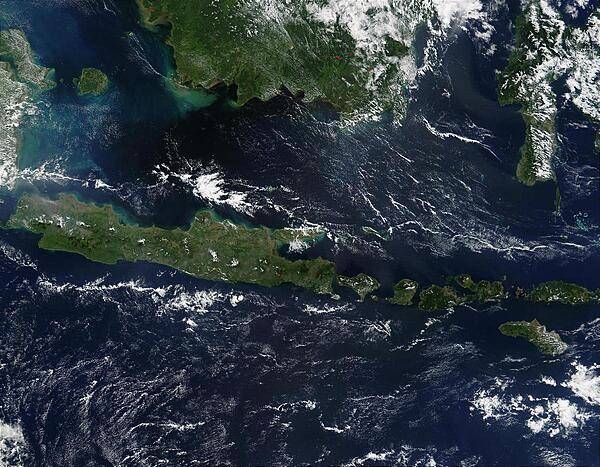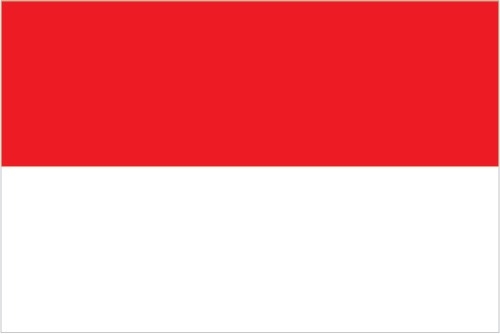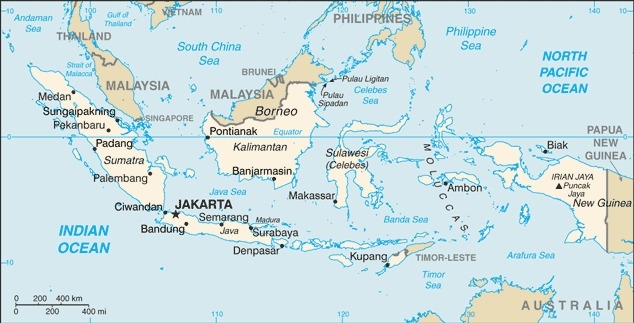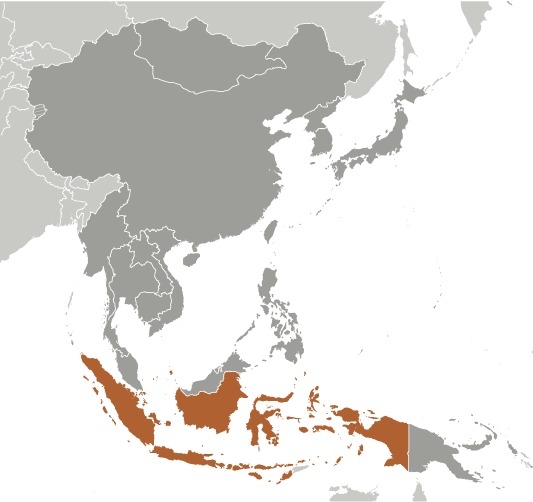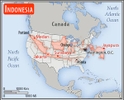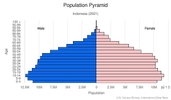Introduction
Background
The archipelago was once largely under the control of Buddhist and Hindu rulers. By around the 7th century, a Buddhist kingdom arose on Sumatra and expanded into Java and the Malay Peninsula until it was conquered in the late 13th century by the Hindu Majapahit Empire from Java. Majapahit (1290-1527) united most of modern-day Indonesia and Malaysia. Traders introduced Islam in the trade ports around the 11th century, and Indonesians gradually adopted Islam over the next 500 years. The Portuguese conquered parts of Indonesia in the 16th century, but they were ousted by the Dutch (except for East Timor), who began colonizing the islands in the early 17th century. It would be the early 20th century before Dutch colonial rule was established across the entirety of what would become the boundaries of the modern Indonesian state.
Japan occupied the islands from 1942 to 1945. Indonesia declared its independence shortly before Japan's surrender, but it required four years of sometimes brutal fighting, intermittent negotiations, and UN mediation before the Netherlands agreed to transfer sovereignty in 1949. A period of sometimes unruly parliamentary democracy ended in 1957 when President SOEKARNO declared martial law and instituted "Guided Democracy." After an abortive coup in 1965 by alleged communist sympathizers, SOEKARNO was gradually eased from power. From 1967 until 1998, President SUHARTO ruled Indonesia with his "New Order" government. After street protests toppled SUHARTO in 1998, free and fair legislative elections took place in 1999. Indonesia is now the world's third most populous democracy, the world's largest archipelagic state, and the world's largest Muslim-majority nation. Current issues include: alleviating poverty, improving education, preventing terrorism, consolidating democracy after four decades of authoritarianism, implementing economic and financial reforms, stemming corruption, reforming the criminal justice system, addressing climate change, and controlling infectious diseases, particularly those of global and regional importance. In 2005, Indonesia reached a historic peace agreement with armed separatists in Aceh. Indonesia continues to face low intensity armed resistance in Papua by the separatist Free Papua Movement.
Visit the Definitions and Notes page to view a description of each topic.
Geography
Location
Southeastern Asia, archipelago between the Indian Ocean and the Pacific Ocean
Geographic coordinates
5 00 S, 120 00 E
Map references
Southeast Asia
Area
total: 1,904,569 sq km
land: 1,811,569 sq km
water: 93,000 sq km
Land boundaries
total: 2,958 km
border countries (3): Malaysia 1881 km, Papua New Guinea 824 km, Timor-Leste 253 km
Coastline
54,716 km
Maritime claims
territorial sea: 12 nm
exclusive economic zone: 200 nm
measured from claimed archipelagic straight baselines
Climate
tropical; hot, humid; more moderate in highlands
Terrain
mostly coastal lowlands; larger islands have interior mountains
Elevation
highest point: Puncak Jaya 4,884 m
lowest point: Indian Ocean 0 m
mean elevation: 367 m
Natural resources
petroleum, tin, natural gas, nickel, timber, bauxite, copper, fertile soils, coal, gold, silver
Land use
agricultural land: 31.2% (2018 est.)
arable land: 13% (2018 est.)
permanent crops: 12.1% (2018 est.)
permanent pasture: 6.1% (2018 est.)
forest: 51.7% (2018 est.)
other: 17.1% (2018 est.)
Irrigated land
67,220 sq km (2012)
Major lakes (area sq km)
Fresh water lake(s): Danau Toba - 1,150 sq km
note - located in the caldera of a super volcano that erupted more than 70,000 years ago; it is the largest volcanic lake in the World
Major rivers (by length in km)
Sepik (shared with Papua New Guinea [s]) - 1,126 km; Fly (shared with Papua New Guinea [s]) - 1,050 km
note – [s] after country name indicates river source; [m] after country name indicates river mouth
Population distribution
major concentration on the island of Java, which is considered one of the most densely populated places on earth; of the outer islands (those surrounding Java and Bali), Sumatra contains some of the most significant clusters, particularly in the south near the Selat Sunda, and along the northeastern coast near Medan; the cities of Makasar (Sulawesi), Banjarmasin (Kalimantan) are also heavily populated
Natural hazards
occasional floods; severe droughts; tsunamis; earthquakes; volcanoes; forest fires
volcanism: Indonesia contains the most volcanoes of any country in the world - some 76 are historically active; significant volcanic activity occurs on Java, Sumatra, the Sunda Islands, Halmahera Island, Sulawesi Island, Sangihe Island, and in the Banda Sea; Merapi (2,968 m), Indonesia's most active volcano and in eruption since 2010, has been deemed a Decade Volcano by the International Association of Volcanology and Chemistry of the Earth's Interior, worthy of study due to its explosive history and close proximity to human populations; on 22 December 2018, a large explosion and flank collapse destroyed most of the 338 m high island of Anak Krakatau (Child of Krakatau) and generated a deadly tsunami inundating portions of western Java and southern Sumatra leaving more than 400 dead; other notable historically active volcanoes include Agung, Awu, Karangetang, Krakatau (Krakatoa), Makian, Raung, Sinabung, and Tambora; see note 2 under "Geography - note"
Geography - note
note 1: according to Indonesia's National Coordinating Agency for Survey and Mapping, the total number of islands in the archipelago is 13,466, of which 922 are permanently inhabited (Indonesia is the world's largest country comprised solely of islands); the country straddles the equator and occupies a strategic location astride or along major sea lanes from the Indian Ocean to the Pacific Ocean
note 2: Indonesia is one of the countries along the Ring of Fire, a belt of active volcanoes and earthquake epicenters bordering the Pacific Ocean; up to 90% of the world's earthquakes and some 75% of the world's volcanoes occur within the Ring of Fire; 80% of tsunamis, caused by volcanic or seismic events, occur within the "Pacific Ring of Fire"
note 3: despite having the fourth largest population in the world, Indonesia is the most heavily forested region on earth after the Amazon
People and Society
Nationality
noun: Indonesian(s)
adjective: Indonesian
Ethnic groups
Javanese 40.1%, Sundanese 15.5%, Malay 3.7%, Batak 3.6%, Madurese 3%, Betawi 2.9%, Minangkabau 2.7%, Buginese 2.7%, Bantenese 2%, Banjarese 1.7%, Balinese 1.7%, Acehnese 1.4%, Dayak 1.4%, Sasak 1.3%, Chinese 1.2%, other 15% (2010 est.)
Languages
Bahasa Indonesia (official, modified form of Malay), English, Dutch, local dialects (of which the most widely spoken is Javanese); note - more than 700 languages are used in Indonesia
major-language sample(s):
Fakta Dunia, sumber informasi dasar yang sangat diperlukan. (Indonesian)
The World Factbook, the indispensable source for basic information.
Religions
Muslim 87.2%, Protestant 7%, Roman Catholic 2.9%, Hindu 1.7%, other 0.9% (includes Buddhist and Confucian), unspecified 0.4% (2010 est.)
Demographic profile
Indonesia has the world’s fourth-largest population. It is predominantly Muslim and has the largest Muslim population of any country in the world. The population is projected to increase to as much as 320 million by 2045. A government-supported family planning program. The total fertility rate (TFR) – the average number of births per woman – from 5.6 in the mid-1960s to 2.7 in the mid-1990s. The success of the program was also due to the social acceptance of family planning, which received backing from influential Muslim leaders and organizations.
The fertility decline slowed in the late 1990’s when responsibility for family planning programs shifted to the district level, where the programs were not prioritized. Since 2012 the national government revitalized the national family planning program, and Indonesia’s TFR has slowly decreased to 2.3 in 2020. The government may reach its goal of achieving replacement level fertility – 2.1 children per woman – but the large number of women of childbearing age ensures significant population growth for many years.
Indonesia is a source country for labor migrants, a transit country for asylum seekers, and a destination mainly for highly skilled migrant workers. International labor migration, both legal and illegal, from Indonesia to other parts of Asia (most commonly Malaysia) and the Middle East has taken place for decades because of high unemployment and underemployment, poverty, and low wages domestically. Increasing numbers of migrant workers are drawn to Australia, Canada, New Zealand, and the US. The majority of Indonesian labor migration is temporary and consists predominantly of low-skilled workers, mainly women working as domestics.
Indonesia’s strategic location between Asia and Australia and between the Pacific and Indian Oceans – and its relatively easy accessibility via boat – appeal to asylum seekers. It is also an attractive transit location because of its easy entry requirements and the ability to continue on to Australia. Recent asylum seekers have come from Afghanistan, Burma (Rohingyas), Iraq, Somalia, and Sri Lanka. Since 2013, when Australia tightening its immigration policy, thousands of migrants and asylum seekers have been stranded in Indonesia, where they live in precarious conditions and receive only limited support from international organizations. The situation for refugees in Indonesia has also worsened because Australia and the US, which had resettled the majority of refugees in Indonesia, have significantly lowered their intake.
Age structure
0-14 years: 23.87% (male 32,473,246/female 31,264,034)
15-24 years: 16.76% (male 22,786,920/female 21,960,130)
25-54 years: 42.56% (male 58,249,570/female 55,409,579)
55-64 years: 8.99% (male 11,033,838/female 12,968,005)
65 years and over: 7.82% (male 9,099,773/female 11,781,271) (2020 est.)
Dependency ratios
total dependency ratio: 47.5
youth dependency ratio: 38.3
elderly dependency ratio: 9.2
potential support ratio: 10.8 (2020 est.)
Median age
total: 31.1 years
male: 30.5 years
female: 31.8 years (2020 est.)
Population distribution
major concentration on the island of Java, which is considered one of the most densely populated places on earth; of the outer islands (those surrounding Java and Bali), Sumatra contains some of the most significant clusters, particularly in the south near the Selat Sunda, and along the northeastern coast near Medan; the cities of Makasar (Sulawesi), Banjarmasin (Kalimantan) are also heavily populated
Urbanization
urban population: 57.3% of total population (2021)
rate of urbanization: 1.99% annual rate of change (2020-25 est.)
Major urban areas - population
10.915 million JAKARTA (capital), 3.510 million Bekasi, 2.972 million Surabaya, 2.607 million Bandung, 2.397 million Tangerang, 2.368 million Medan (2021)
Sex ratio
at birth: 1.05 male(s)/female
0-14 years: 1.04 male(s)/female
15-24 years: 1.04 male(s)/female
25-54 years: 1.05 male(s)/female
55-64 years: 0.85 male(s)/female
65 years and over: 0.77 male(s)/female
total population: 1 male(s)/female (2020 est.)
Mother's mean age at first birth
22.4 years (2017 est.)
note: median age at first birth among women 25-49
Maternal mortality ratio
177 deaths/100,000 live births (2017 est.)
country comparison to the world: 52Infant mortality rate
total: 20.16 deaths/1,000 live births
male: 22.59 deaths/1,000 live births
female: 17.6 deaths/1,000 live births (2021 est.)
Life expectancy at birth
total population: 72.82 years
male: 70.62 years
female: 75.12 years (2021 est.)
Contraceptive prevalence rate
55.5% (2018)
Drinking water source
improved: urban: 96.6% of population
rural: 83.7% of population
total: 90.8% of population
unimproved: urban: 3.4% of population
rural: 16.3% of population
total: 9.2% of population (2017 est.)
Current Health Expenditure
2.9% (2018)
Physicians density
0.43 physicians/1,000 population (2018)
Hospital bed density
1 beds/1,000 population (2017)
Sanitation facility access
improved: urban: 92.5% of population
rural: 76.8% of population
total: 85.4% of population
unimproved: urban: 7.5% of population
rural: 23.2% of population
total: 14.6% of population (2017 est.)
Major infectious diseases
degree of risk: very high (2020)
food or waterborne diseases: bacterial diarrhea, hepatitis A, and typhoid fever
vectorborne diseases: dengue fever and malaria
note: a new coronavirus is causing sustained community spread of respiratory illness (COVID-19) in Indonesia; as of 6 October 2021, Indonesia has reported a total of 4,223,094 cases of COVID-19 or 1,543.96 cumulative cases of COVID-19 per 100,000 population with 52.07 cumulative deaths per 100,000 population; as of 5 October 2021, 34.36% of the population has received at least one dose of COVID-19 vaccine
Literacy
definition: age 15 and over can read and write
total population: 96%
male: 97.4%
female: 94.6% (2020)
School life expectancy (primary to tertiary education)
total: 14 years
male: 14 years
female: 14 years (2018)
Unemployment, youth ages 15-24
total: 14.8%
male: 15.1%
female: 14.3% (2020 est.)
Environment
Environment - current issues
large-scale deforestation (much of it illegal) and related wildfires cause heavy smog; over-exploitation of marine resources; environmental problems associated with rapid urbanization and economic development, including air pollution, traffic congestion, garbage management, and reliable water and waste water services; water pollution from industrial wastes, sewage
Environment - international agreements
party to: Biodiversity, Climate Change, Climate Change-Kyoto Protocol, Climate Change-Paris Agreement, Comprehensive Nuclear Test Ban, Desertification, Endangered Species, Hazardous Wastes, Law of the Sea, Nuclear Test Ban, Ozone Layer Protection, Ship Pollution, Tropical Timber 2006, Wetlands
signed, but not ratified: Marine Life Conservation
Air pollutants
particulate matter emissions: 15.58 micrograms per cubic meter (2016 est.)
carbon dioxide emissions: 563.32 megatons (2016 est.)
methane emissions: 244.5 megatons (2020 est.)
Climate
tropical; hot, humid; more moderate in highlands
Land use
agricultural land: 31.2% (2018 est.)
arable land: 13% (2018 est.)
permanent crops: 12.1% (2018 est.)
permanent pasture: 6.1% (2018 est.)
forest: 51.7% (2018 est.)
other: 17.1% (2018 est.)
Urbanization
urban population: 57.3% of total population (2021)
rate of urbanization: 1.99% annual rate of change (2020-25 est.)
Revenue from forest resources
forest revenues: 0.39% of GDP (2018 est.)
country comparison to the world: 71Major infectious diseases
degree of risk: very high (2020)
food or waterborne diseases: bacterial diarrhea, hepatitis A, and typhoid fever
vectorborne diseases: dengue fever and malaria
note: a new coronavirus is causing sustained community spread of respiratory illness (COVID-19) in Indonesia; as of 6 October 2021, Indonesia has reported a total of 4,223,094 cases of COVID-19 or 1,543.96 cumulative cases of COVID-19 per 100,000 population with 52.07 cumulative deaths per 100,000 population; as of 5 October 2021, 34.36% of the population has received at least one dose of COVID-19 vaccine
Waste and recycling
municipal solid waste generated annually: 65.2 million tons (2016 est.)
municipal solid waste recycled annually: 4.564 million tons (2016 est.)
percent of municipal solid waste recycled: 7% (2016 est.)
Major lakes (area sq km)
Fresh water lake(s): Danau Toba - 1,150 sq km
note - located in the caldera of a super volcano that erupted more than 70,000 years ago; it is the largest volcanic lake in the World
Major rivers (by length in km)
Sepik (shared with Papua New Guinea [s]) - 1,126 km; Fly (shared with Papua New Guinea [s]) - 1,050 km
note – [s] after country name indicates river source; [m] after country name indicates river mouth
Total water withdrawal
municipal: 23.8 billion cubic meters (2017 est.)
industrial: 9.135 billion cubic meters (2017 est.)
agricultural: 189.7 billion cubic meters (2017 est.)
Total renewable water resources
2,018,700,000,000 cubic meters (2017 est.)
Government
Country name
conventional long form: Republic of Indonesia
conventional short form: Indonesia
local long form: Republik Indonesia
local short form: Indonesia
former: Netherlands East Indies, Dutch East Indies
etymology: the name is an 18th-century construct of two Greek words, "Indos" (India) and "nesoi" (islands), meaning "Indian islands"
Government type
presidential republic
Capital
name: Jakarta
geographic coordinates: 6 10 S, 106 49 E
time difference: UTC+7 (12 hours ahead of Washington, DC, during Standard Time)
time zone note: Indonesia has three time zones
etymology: "Jakarta" derives from the Sanscrit "Jayakarta" meaning "victorious city" and refers to a successful defeat and expulsion of the Portuguese in 1527; previously the port had been named "Sunda Kelapa"
Administrative divisions
31 provinces (provinsi-provinsi, singular - provinsi), 1 autonomous province*, 1 special region** (daerah-daerah istimewa, singular - daerah istimewa), and 1 national capital district*** (daerah khusus ibukota); Aceh*, Bali, Banten, Bengkulu, Gorontalo, Jakarta***, Jambi, Jawa Barat (West Java), Jawa Tengah (Central Java), Jawa Timur (East Java), Kalimantan Barat (West Kalimantan), Kalimantan Selatan (South Kalimantan), Kalimantan Tengah (Central Kalimantan), Kalimantan Timur (East Kalimantan), Kalimantan Utara (North Kalimantan), Kepulauan Bangka Belitung (Bangka Belitung Islands), Kepulauan Riau (Riau Islands), Lampung, Maluku, Maluku Utara (North Maluku), Nusa Tenggara Barat (West Nusa Tenggara), Nusa Tenggara Timur (East Nusa Tenggara), Papua, Papua Barat (West Papua), Riau, Sulawesi Barat (West Sulawesi), Sulawesi Selatan (South Sulawesi), Sulawesi Tengah (Central Sulawesi), Sulawesi Tenggara (Southeast Sulawesi), Sulawesi Utara (North Sulawesi), Sumatera Barat (West Sumatra), Sumatera Selatan (South Sumatra), Sumatera Utara (North Sumatra), Yogyakarta**
note: following the implementation of decentralization beginning on 1 January 2001, regencies and municipalities have become the key administrative units responsible for providing most government services
Independence
17 August 1945 (declared independence from the Netherlands)
National holiday
Independence Day, 17 August (1945)
Constitution
history: drafted July to August 1945, effective 18 August 1945, abrogated by 1949 and 1950 constitutions; 1945 constitution restored 5 July 1959
amendments: proposed by the People’s Consultative Assembly, with at least two thirds of its members present; passage requires simple majority vote by the Assembly membership; constitutional articles on the unitary form of the state cannot be amended; amended several times, last in 2002
Legal system
civil law system based on the Roman-Dutch model and influenced by customary law
International law organization participation
has not submitted an ICJ jurisdiction declaration; non-party state to the ICCt
Citizenship
citizenship by birth: no
citizenship by descent only: at least one parent must be a citizen of Indonesia
dual citizenship recognized: no
residency requirement for naturalization: 5 continuous years
Suffrage
17 years of age; universal and married persons regardless of age
Executive branch
chief of state: President Joko WIDODO (since 20 October 2014, reelected 17 April 2019, inauguration 19 October 2019); Vice President Ma'ruf AMIN (since 20 October 2019); note - the president is both chief of state and head of government (2019)
head of government: President Joko WIDODO (since 20 October 2014); Vice President Ma'ruf AMIN (since 20 October 2019) (2019)
cabinet: Cabinet appointed by the president
elections/appointments: president and vice president directly elected by absolute majority popular vote for a 5-year term (eligible for a second term); election last held on 17 April 2019 (next election 2024)
election results: Joko WIDODO elected president; percent of vote - Joko WIDODO (PDI-P) 55.5%, PRABOWO Subianto Djojohadikusumo (GERINDRA) 44.5%
Legislative branch
description: bicameral People's Consultative Assembly or Majelis Permusyawaratan Rakyat consists of:
Regional Representative Council or Dewan Perwakilan Daerah (136 seats; non-partisan members directly elected in multi-seat constituencies - 4 each from the country's 34 electoral districts - by proportional representation vote to serve 5-year terms); note - the Regional Representative Council has no legislative authority
House of Representatives or Dewan Perwakilan Rakyat (575 seats; members directly elected in multi-seat constituencies by single non-transferable vote to serve 5-year terms) (2019)
elections: Regional Representative Council - last held 17 April 2019 (next to be held 2024)
House of Representatives - last held on 17 April 2019 (next to be held 2024) (2019)
election results: Regional Representative Council - all seats elected on a non-partisan basis; compostion - NA
House of Representatives - percent of vote by party - PDI-P 19.3%, Gerindra 12.6%, Golkar 12.3%, PKB 9.7%, Nasdem 9.1%, PKS 8.2%, PD 7.8%, PAN 6.8%, PPP 4.5%, other 9.6%; seats by party - PDI-P 128, Golkar 85, Gerindra 78, Nasdem 59, PKB 58, PD 54, PKS 50, PAN 44, PPP 19; composition - men 475, women 100, percent of women 17.9%; total People's Consultative Assembly percent of women NA (2019)
Judicial branch
highest courts: Supreme Court or Mahkamah Agung (51 judges divided into 8 chambers); Constitutional Court or Mahkamah Konstitusi (consists of 9 judges)
judge selection and term of office: Supreme Court judges nominated by Judicial Commission, appointed by president with concurrence of parliament; judges serve until retirement at age 65; Constitutional Court judges - 3 nominated by president, 3 by Supreme Court, and 3 by parliament; judges appointed by the president; judges serve until mandatory retirement at age 70
subordinate courts: High Courts of Appeal, district courts, religious courts
Political parties and leaders
Democrat Party or PD [Agus Harimurti YUDHOYONO]
Functional Groups Party or GOLKAR [Airlangga HARTARTO]
Great Indonesia Movement Party or GERINDRA [PRABOWO Subianto Djojohadikusumo]
Indonesia Democratic Party-Struggle or PDI-P [MEGAWATI Sukarnoputri]
National Awakening Party or PKB [Muhaiman ISKANDAR]
National Democratic Party or NasDem [Surya PALOH]
National Mandate Party or PAN [Zulkifli HASAN]
Prosperous Justice Party or PKS [Ahmad SYAIKHU]
United Development Party or PPP [Suharso MONOARFA] (2021)
International organization participation
ADB, APEC, ARF, ASEAN, BIS, CD, CICA (observer), CP, D-8, EAS, EITI (compliant country), FAO, G-11, G-15, G-20, G-77, IAEA, IBRD, ICAO, ICC (national committees), ICRM, IDA, IDB, IFAD, IFC, IFRCS, IHO, ILO, IMF, IMO, IMSO, Interpol, IOC, IOM (observer), IORA, IPU, ISO, ITSO, ITU, ITUC (NGOs), MIGA, MINURSO, MINUSTAH, MONUSCO, MSG (associate member), NAM, OECD (enhanced engagement), OIC, OPCW, PIF (partner), UN, UNAMID, UNCTAD, UNESCO, UNIDO, UNIFIL, UNISFA, UNMIL, UNWTO, UPU, WCO, WFTU (NGOs), WHO, WIPO, WMO, WTO
Diplomatic representation in the US
chief of mission: Ambassador (vacant); Iwan Freddy Hari SUSANTO, Minister (since 1 April 2021)
chancery: 2020 Massachusetts Avenue NW, Washington, DC 20036
telephone: [1] (202) 775-5200
FAX: [1] (202) 775-5365
email address and website:
http://www.embassyofindonesia.org/
consulate(s) general: Chicago, Houston, Los Angeles, New York, San Francisco
Diplomatic representation from the US
chief of mission:
Ambassador Sung Y. KIM (since 21 October 2020)
embassy: Jl. Medan Merdeka Selatan No. 3-5, Jakarta 10110
mailing address: 8200 Jakarta Place, Washington DC 8200
telephone: [62] (21) 5083-1000 (2020)
FAX: [62] (21) 385-7189 (2018)
email address and website:
jakartaacs@state.gov
https://id.usembassy.gov/
consulate(s) general: Surabaya
consulate(s): Medan
Flag description
two equal horizontal bands of red (top) and white; the colors derive from the banner of the Majapahit Empire of the 13th-15th centuries; red symbolizes courage, white represents purity
note: similar to the flag of Monaco, which is shorter; also similar to the flag of Poland, which is white (top) and red
National symbol(s)
garuda (mythical bird); national colors: red, white
National anthem
name: "Indonesia Raya" (Great Indonesia)
lyrics/music: Wage Rudolf SOEPRATMAN
note: adopted 1945
Economy
Economic overview
Indonesia, the largest economy in Southeast Asia, has seen a slowdown in growth since 2012, mostly due to the end of the commodities export boom. During the global financial crisis, Indonesia outperformed its regional neighbors and joined China and India as the only G20 members posting growth. Indonesia’s annual budget deficit is capped at 3% of GDP, and the Government of Indonesia lowered its debt-to-GDP ratio from a peak of 100% shortly after the Asian financial crisis in 1999 to 34% today. In May 2017 Standard & Poor’s became the last major ratings agency to upgrade Indonesia’s sovereign credit rating to investment grade.
Poverty and unemployment, inadequate infrastructure, corruption, a complex regulatory environment, and unequal resource distribution among its regions are still part of Indonesia’s economic landscape. President Joko WIDODO - elected in July 2014 – seeks to develop Indonesia’s maritime resources and pursue other infrastructure development, including significantly increasing its electrical power generation capacity. Fuel subsidies were significantly reduced in early 2015, a move which has helped the government redirect its spending to development priorities. Indonesia, with the nine other ASEAN members, will continue to move towards participation in the ASEAN Economic Community, though full implementation of economic integration has not yet materialized.
Real GDP (purchasing power parity)
$3,130,470,000,000 note: data are in 2017 dollars (2020 est.)
$3,196,620,000,000 note: data are in 2017 dollars (2019 est.)
$3,043,880,000,000 note: data are in 2017 dollars (2018 est.)
note: data are in 2010 dollars
Real GDP growth rate
5.03% (2019 est.)
5.17% (2018 est.)
5.07% (2017 est.)
Real GDP per capita
$11,400 note: data are in 2017 dollars (2020 est.)
$11,800 note: data are in 2017 dollars (2019 est.)
$11,400 note: data are in 2017 dollars (2018 est.)
note: data are in 2010 dollars
GDP (official exchange rate)
$1,119,720,000,000 (2019 est.)
Inflation rate (consumer prices)
2.8% (2019 est.)
3.2% (2018 est.)
3.8% (2017 est.)
Credit ratings
Fitch rating: BBB (2017)
Moody's rating: Baa2 (2018)
Standard & Poors rating: BBB (2019)
GDP - composition, by sector of origin
agriculture: 13.7% (2017 est.)
industry: 41% (2017 est.)
services: 45.4% (2017 est.)
GDP - composition, by end use
household consumption: 57.3% (2017 est.)
government consumption: 9.1% (2017 est.)
investment in fixed capital: 32.1% (2017 est.)
investment in inventories: 0.3% (2017 est.)
exports of goods and services: 20.4% (2017 est.)
imports of goods and services: -19.2% (2017 est.)
Agricultural products
oil palm fruit, rice, maize, sugar cane, coconuts, cassava, bananas, eggs, poultry, rubber
Industries
petroleum and natural gas, textiles, automotive, electrical appliances, apparel, footwear, mining, cement, medical instruments and appliances, handicrafts, chemical fertilizers, plywood, rubber, processed food, jewelry, and tourism
Labor force - by occupation
agriculture: 32%
industry: 21%
services: 47% (2016 est.)
Population below poverty line
9.4% (2019 est.)
Gini Index coefficient - distribution of family income
37.8 (2018 est.)
39.4 (2005)
Household income or consumption by percentage share
lowest 10%: 3.4%
highest 10%: 28.2% (2010)
Budget
revenues: 131.7 billion (2017 est.)
expenditures: 159.6 billion (2017 est.)
Fiscal year
calendar year
Current account balance
-$30.359 billion (2019 est.)
-$30.633 billion (2018 est.)
Exports
$178.26 billion note: data are in current year dollars (2020 est.)
$200.1 billion note: data are in current year dollars (2019 est.)
$211.93 billion note: data are in current year dollars (2018 est.)
Exports - partners
China 15%, United States 10%, Japan 9%, Singapore 8%, India 7%, Malaysia 5% (2019)
Exports - commodities
coal, palm oil, natural gas, cars, gold (2019)
Imports
$159.64 billion note: data are in current year dollars (2020 est.)
$204.23 billion note: data are in current year dollars (2019 est.)
$218.65 billion note: data are in current year dollars (2018 est.)
Imports - partners
China 27%, Singapore 12%, Japan 8%, Thailand 5%, United States 5%, South Korea 5%, Malaysia 5% (2019)
Imports - commodities
refined petroleum, crude petroleum, vehicle parts, telephones, natural gas (2019)
Reserves of foreign exchange and gold
$130.2 billion (31 December 2017 est.)
country comparison to the world: 20Debt - external
$393.252 billion (2019 est.)
$360.945 billion (2018 est.)
Exchange rates
Indonesian rupiah (IDR) per US dollar -
14,110 (2020 est.)
14,015 (2019 est.)
14,470 (2018 est.)
13,389.4 (2014 est.)
11,865.2 (2013 est.)
Unemployment, youth ages 15-24
total: 14.8%
male: 15.1%
female: 14.3% (2020 est.)
Energy
Electricity access
electrification - total population: 99% (2019)
electrification - urban areas: 100% (2019)
electrification - rural areas: 99% (2019)
Electricity - installed generating capacity
61.43 million kW (2016 est.)
country comparison to the world: 19Electricity - from fossil fuels
85% of total installed capacity (2016 est.)
country comparison to the world: 71Electricity - from nuclear fuels
0% of total installed capacity (2017 est.)
country comparison to the world: 110Electricity - from hydroelectric plants
9% of total installed capacity (2017 est.)
country comparison to the world: 118Electricity - from other renewable sources
6% of total installed capacity (2017 est.)
country comparison to the world: 98Crude oil - proved reserves
3.31 billion bbl (1 January 2018 est.)
country comparison to the world: 28Refined petroleum products - production
950,000 bbl/day (2015 est.)
country comparison to the world: 18Refined petroleum products - consumption
1.601 million bbl/day (2016 est.)
country comparison to the world: 14Natural gas - proved reserves
2.866 trillion cu m (1 January 2018 est.)
country comparison to the world: 12Communications
Telephones - fixed lines
total subscriptions: 9,186,370 (2020)
subscriptions per 100 inhabitants: 3.36 (2020 est.)
Telephones - mobile cellular
total subscriptions: 355,748,606 (2020)
subscriptions per 100 inhabitants: 130.1 (2020 est.)
Telecommunication systems
general assessment: Indonesia’s telecom sector is based on 3G/LTE mobile infrastructure and inadequate fixed-line capacity; large population and disbursed island geography make upgrades difficult; market is attracting foreign investment, especially in data center and cloud based services; tests of 5G challenged by lack of spectrum; satellite improvements in 2020 (2020)
domestic: fixed-line 4 per 100 and mobile-cellular 127 per 100 persons; coverage provided by existing network has been expanded by use of over 200,000 telephone kiosks many located in remote areas; mobile-cellular subscribership growing rapidly (2019)
international: country code - 62; landing points for the SEA-ME-WE-3 & 5, DAMAI, JASUKA, BDM, Dumai-Melaka Cable System, IGG, JIBA, Link 1, 3, 4, & 5, PGASCOM, B3J2, Tanjung Pandam-Sungai Kakap Cable System, JAKABARE, JAYABAYA, INDIGO-West, Matrix Cable System, ASC, SJJK, Jaka2LaDeMa, S-U-B Cable System, JBCS, MKCS, BALOK, Palapa Ring East, West and Middle, SMPCS Packet-1 and 2, LTCS, TSCS, SEA-US and Kamal Domestic Submarine Cable System, 35 submarine cable networks that provide links throughout Asia, the Middle East, Australia, Southeast Asia, Africa and Europe; satellite earth stations - 2 Intelsat (1 Indian Ocean and 1 Pacific Ocean) (2019)
note: the COVID-19 pandemic continues to have a significant impact on production and supply chains globally; since 2020, some aspects of the telecom sector have experienced downturn, particularly in mobile device production; many network operators delayed upgrades to infrastructure; progress towards 5G implementation was postponed or slowed in some countries; consumer spending on telecom services and devices was affected by large-scale job losses and the consequent restriction on disposable incomes; the crucial nature of telecom services as a tool for work and school from home became evident, and received some support from governments
Broadcast media
mixture of about a dozen national TV networks - 1 public broadcaster, the remainder private broadcasters - each with multiple transmitters; more than 100 local TV stations; widespread use of satellite and cable TV systems; public radio broadcaster operates 6 national networks, as well as regional and local stations; overall, more than 700 radio stations with more than 650 privately operated (2019)
Internet users
total: 202.6 million (2021 est.)
percent of population: 53.73% (2020 est.)
Broadband - fixed subscriptions
total: 10,713,107 (2020)
subscriptions per 100 inhabitants: 3.92 (2020 est.)
Transportation
National air transport system
number of registered air carriers: 25 (2020)
inventory of registered aircraft operated by air carriers: 611
annual passenger traffic on registered air carriers: 115,154,100 (2018)
annual freight traffic on registered air carriers: 1,131,910,000 mt-km (2018)
Airports - with paved runways
total: 186
over 3,047 m: 5
2,438 to 3,047 m: 21
1,524 to 2,437 m: 51
914 to 1,523 m: 72
under 914 m: 37 (2017)
Airports - with unpaved runways
total: 487
1,524 to 2,437 m: 4
914 to 1,523 m: 23
under 914 m: 460 (2013)
Heliports
76 (2013)
Pipelines
1064 km condensate, 150 km condensate/gas, 11702 km gas, 119 km liquid petroleum gas, 7767 km oil, 77 km oil/gas/water, 728 km refined products, 53 km unknown, 44 km water (2013)
Railways
total: 8,159 km (2014)
narrow gauge: 8,159 km 1.067-m gauge (565 km electrified) (2014)
note: 4,816 km operational
Roadways
total: 496,607 km (2011)
paved: 283,102 km (2011)
unpaved: 213,505 km (2011)
Merchant marine
total: 10,427
by type: bulk carrier 148, container ship 226, general cargo 2,238, oil tanker 676, other 7,139 (2021)
Ports and terminals
major seaport(s): Banjarmasin, Belawan, Kotabaru, Krueg Geukueh, Palembang, Panjang, Sungai Pakning, Tanjung Perak, Tanjung Priok
container port(s) (TEUs): Tanjung Perak (3,900,000), Tanjung Priok (7,600,000) (2019)
LNG terminal(s) (export): Bontang, Tangguh
LNG terminal(s) (import): Arun, Lampung, West Java
Military and Security
Military and security forces
Indonesian National Armed Forces (Tentara Nasional Indonesia, TNI): Army (TNI-Angkatan Darat (TNI-AD)), Navy (TNI-Angkatan Laut (TNI-AL), includes Marine Corps (Korps Marinir, KorMar), Naval Aviation Center (PUSPENERBAL)), Air Force (TNI-Angkatan Udara (TNI-AU)), National Air Defense Command (Komando Pertahanan Udara Nasional (Kohanudnas)), Armed Forces Special Operations Command (Kopassus), Strategic Reserve Command (Kostrad), National Army Reserve Component (Komcad)
Indonesian Sea and Coast Guard (Kesatuan Penjagaan Laut dan Pantai, KPLP) is under the Ministry of Transportation (2021)
note(s) - the Indonesian National Police includes a paramilitary Mobile Brigade Corps (BRIMOB); following the Bali terror bombing in 2002, the National Police formed a special counter-terrorism force called Detachment 88 (Densus or Detasemen Khusus 88 Antiteror)
Military expenditures
0.8% of GDP (2021 est.)
0.8% of GDP (2020)
0.7% of GDP (2019)
0.7% of GDP (2018)
0.9% of GDP (2017)
Military and security service personnel strengths
the Indonesian National Armed Forces have approximately, 400,000 active duty troops (300,000 Army; 65,000 Navy, including about 20,000 marines; 30,000 Air Force) (2021)
Military equipment inventories and acquisitions
the Indonesian military inventory is comprised of equipment from a wide variety of sources; since 2010, the top suppliers are China, Germany, the Netherlands, Russia, South Korea, the UK, and the US; Indonesia has a growing defense industry fueled by technology transfers and cooperation agreements with several countries; in 2019, the Indonesian Government publicly said that growing its domestic defense industry is a national priority over the next 5-10 years (2021)
Military deployments
230 Central African Republic (MINUSCA); 1,030 Democratic Republic of the Congo (MONUSCO); 1,230 Lebanon (UNIFIL) (Oct 2021)
Maritime threats
the International Maritime Bureau continues to report the territorial and offshore waters in the Strait of Malacca and South China Sea as high risk for piracy and armed robbery against ships; the number of attacks increased slightly from 25 incidents in 2019 to 26 in 2020 due to aggressive maritime patrolling by regional authorities; vessels continue to be boarded while anchored or berthed at Indonesian ports with two crew taken hostage and two threatened in 2020; hijacked vessels are often disguised and cargo diverted to ports in East Asia
Military service age and obligation
18-45 years of age for voluntary military service, with selective conscription authorized; 2-year service obligation, with reserve obligation to age 45 (officers); Indonesian citizens only (2021)
Military - note
as of 2021, Indonesian military and police forces were engaged in counter-insurgency operations in Papua against the West Papua Liberation Army, the military wing of the Free Papua Organization, which has been fighting a low-level insurgency since the 1960s when Indonesia annexed the former Dutch colony; since 2019, there has been an increase in militant activity in Papua and a larger Indonesian military presence; Papua was formally incorporated into Indonesia in 1969; in addition, the Indonesian military has been assisting police in countering the Mujahideen Indonesia Timur (MIT; aka East Indonesia Mujahideen), a local Islamic State (ISIS)-affiliated terrorist group
Indonesia is not a formal claimant in the South China Sea, although some of its waters lie within China's “nine-dash line” maritime claims, resulting in some stand offs in recent years; since 2016, the Indonesian military has bolstered its presence on Great Natuna Island (aka Pulau Natuna Besar), the main island of the Middle Natuna Archipelago, which is part of the Riau Islands Province, and held military exercises in surrounding waters
Terrorism
Terrorist group(s)
Islamic State of Iraq and ash-Sham (aka Jemaah Anshorut Daulah); Jemaah Islamiyah
note: details about the history, aims, leadership, organization, areas of operation, tactics, targets, weapons, size, and sources of support of the group(s) appear(s) in Appendix-T
Transnational Issues
Disputes - international
Indonesia has a stated foreign policy objective of establishing stable fixed land and maritime boundaries with all of its neighbors; three stretches of land borders with Timor-Leste have yet to be delimited, two of which are in the Oecussi exclave area, and no maritime or Exclusive Economic Zone (EEZ) boundaries have been established between the countries; all borders between Indonesia and Australia have been agreed upon bilaterally, but a 1997 treaty that would settle the last of their maritime and EEZ boundary has yet to be ratified by Indonesia's legislature; Indonesian groups challenge Australia's claim to Ashmore Reef; Australia has closed parts of the Ashmore and Cartier Reserve to Indonesian traditional fishing and placed restrictions on certain catches; land and maritime negotiations with Malaysia are ongoing, and disputed areas include the controversial Tanjung Datu and Camar Wulan border area in Borneo and the maritime boundary in the Ambalat oil block in the Celebes Sea; Indonesia and Singapore continue to work on finalizing their 1973 maritime boundary agreement by defining unresolved areas north of Indonesia's Batam Island; Indonesian secessionists, squatters, and illegal migrants create repatriation problems for Papua New Guinea; maritime delimitation talks continue with Palau; EEZ negotiations with Vietnam are ongoing, and the two countries in Fall 2011 agreed to work together to reduce illegal fishing along their maritime boundary
Refugees and internally displaced persons
refugees (country of origin): 5,863 (Afghanistan) (2020)
IDPs: 40,000 (inter-communal, inter-faith, and separatist violence between 1998 and 2004 in Aceh and Papua; religious attacks and land conflicts in 2007 and 2013; most IDPs in Aceh, Maluku, East Nusa Tengarra) (2020)
stateless persons: 874 (2020)
Illicit drugs
a transit and destination point for illicit narcotics; consumer of crystal methamphetamine trafficked in Burma and Pakistan and also transit to Australia and New Zealand; significant consumer of ecstasy from China and the Netherlands and domestically grown cannabis
